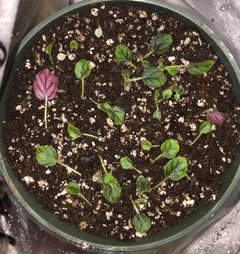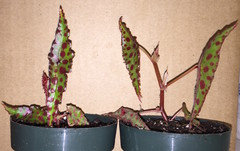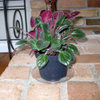Sinningia Propagation
I would like input on methods of propagating sinningias. I love the tuberous mini's and micro mini's such as S. coccina, S. White Sprite, S. Dollbaby and S. pusilla.
I know those to be tuberous but darned if I know how to make more beyond them flowering and setting seed!!!
And I also have a S. Bewitched. I don't know if that is a tuber or not. Haven't googled it yet.
There are always many ways to do the same thing, so how about some input to help those like me? Thanks!!! Rosie
Comments (25)
Bourbon Milkshake
6 years agoHello hello. I have nothing useful to say except I will be watching this thread like a hawk. Me, who has killed 3 Sinningias in a row (1 leucotricha and 2 tubiflora, RIP). One day I will have Sinningia magic. Today I am taking notes. Thanks in advance, everyone!
Rosie1949 thanked Bourbon MilkshakeRosie1949
Original Author6 years agoHi! Hope we get people who are "in the know" about Sin. propagation!!! Rosie
Related Professionals
Pelham Landscape Contractors · Stamford Landscape Contractors · Aberdeen Landscape Contractors · Elmhurst Landscape Contractors · Fair Lawn Landscape Contractors · Fairfield Landscape Contractors · Golden Gate Landscape Contractors · Lakeville Landscape Contractors · Nashua Landscape Contractors · Peachtree City Landscape Contractors · Siloam Springs Landscape Contractors · Colorado Springs Siding & Exteriors · Layton Siding & Exteriors · Loveland Siding & Exteriors · North Bellmore Siding & Exteriorsmark4321_gw
6 years agolast modified: 6 years agoHere's what they look like about 10 days later. Two things to note: those that started with more than one leaf are turning into plants very quickly. Second, the isolated leaves are already starting to form small tubers.

Here some old ones I had sitting around. I've removed a number of these--somewhere between 6 and 10. Some may end up never sprouting, but I've already gotten quite few.
 Rosie1949 thanked mark4321_gw
Rosie1949 thanked mark4321_gwmark4321_gw
6 years agoAnd this a question for anyone, but particularly for Irina. Would any of the following be interesting tests of the ziploc bag method--that is, species/hybrids which are know to be possible from leaves, but very difficult.
Here are the Sinningias I grow right now:
S. helleriS. sp. 'Pancas'
S. iarae
S. tubiflora
S. defoliata
S. araneosa.
S. pusilla
S. pusilla hybrid, perhaps 'Maryjane's Pixie'*
S. speciosa, possibly 'Touch of Spice'*
S. pireseana
S. 'HCY's Centre Heart'*
S. 'Prudence Risley'
I have successfully started those with an asterisk (*) from leaf cuttings. I have tried and failed with S. helleri (conventional propagation) and 'Prudence Risley' (ziploc bag).
Rosie1949 thanked mark4321_gwRosie1949
Original Author6 years agoAHA! Randy I was hoping you would find it and join in! Yes,,,,I guess I jumped the gun but seeing as how I am trying to learn about Sin. Prop myself I just went with it! Still can't get over "blind tubers"! chuckle
What do you mean by zip lock bag method? To me that means some soil mix in a zip lock baggie and put in a leaf. Viola! and hope for the best? Rosie
irina_co
6 years agoRandy-
I am pretty sure that a success of a ziplock propagation correlates with an ability to propagate Sinns from leaves. If you cannot propagate this species/hybrid from leaves in a conventional way - you cannot propagate it in a ziplock. You still can meristem propagate them - because of the hormones in a micropropagation media.
So far out of your list - S.pusilla and S.speciosa will work for sure- probably sp. Pancas too - the rest - occasionally, no guarantee - or not at all.
I.
Rosie1949 thanked irina_comark4321_gw
6 years agoThanks. It is those whose propagation is possible but difficult from leaves that would be the best test. I was thinking about trying S. helleri at some point. For those not familiar with that species, it's the type species of the genus, but disappeared from cultivation (~100 years). It was rediscovered and Mauro Peixoto (brazilplants) distributed seeds. Here's a picture of one from a sale in San Francisco, a plant from one of the members of the SF Gesneriad Society. I'm not sure if it's Hung Nguyen's plant, but I believe he was the first to bloom it in the U.S. I bought a plant from the SF Gesneriad Society and also got seeds from the Gesneriad seed fund (which germinated). A friend has an enormous plant in his unheated greenhouse which is one of the seedlings. I think it has buds.

My friend's plant, which I think is a photo from Dec. 5th. It's bigger now! Rosie1949 thanked mark4321_gw
Rosie1949 thanked mark4321_gwmark4321_gw
6 years agoIrina, I have had Begonias propagate easily for me in the ziploc, which always fail miserably as leaves and/or pieces of leaves. Examples are B. brevirimosa (fails from leaf pieces--they are quickly chewed up by some sort of pathogen that I'm convinced comes on the leaves. B. U614: paper thin leaves have their petioles rot if rooted in water, and pieces never make it in perlite (for me, I've gotten different reports from others ). I've never actually tried leaves of B. amphioxus, but I've been told it's near impossible. I got several plants from leaf fragments the first time I tried. These came from such leaf fragments:

I've been rooting Begonias for a long time and I generally have a good idea of what's easy and what's hard. However, with Gesneriads, I don't have a good sense, and I don't have much to compare to.
I would expect that some Gesneriads are easier with this method, and some are harder. I've run into easy Begonias which suddenly become difficult, or slow: examples include Begonia carolineifolia (so far, impossible) and B. bogneri (i finally saw some roots). I can't make any general conclusions about Gesneriads before I've even tried many.
That's exactly why I've been asking about any Gesneriad (of course, especially those that I have) which are capable of being propagated from leaves, yet are difficult. I've only tried to root Columnea brenneri a couple times by leaf cuttings using conventional methods. i have such a huge surplus of that plant there's not a huge motivation to propagate more. However, I should try the ziploc method, especially since the leaves quickly die--they just don't sit there and fail to root. That suggests to me some sort of pathogen(s) may be involved, which is a good reason to try a more sterile environment.
mark4321_gw
6 years agoRosie, back to the micro mini propagation. Another way to do it is just take a big plant and split it into anything that might grow. Here's what i started with:

In case you're wondering, the flowers survived this process, and lived for quite a while after this!I just ripped the above plant apart, and then organized what I had, then potted everything up:

Unfortunately I wasn't organized enough to track exactly what grew and didn't. I think those with both leaves and tubers were the most likely to yield plants. I got a huge number of plants from this. I think I would have gotten even more if I had timed it better, as I think it was approaching dormancy at this point.Rosie1949 thanked mark4321_gwRosie1949
Original Author6 years agoRandy is everything growing under lights of some sort? I do have 3 separate plants of my sinningia pusilla all in one small container with a lid on it for humidity.
The three little plants do not need to be separated yet. They are sort of still single crown. I don't want to really mess with them until I have that full pot I have been (im)patiently waiting for. Also I am trying to hold off transplanting her with fresh soil in case there may be seeds on the soil. I don't want to lose any potential babies! Honestly by now I would have thought I would have more plants growing in there.
She is blooming again, and one of the flowers looks like I may have a seed pod! Of course it may be too soon to tell if I will get seed/babies but I hope so. I have her about 8 inches from my east window so she probably needs more light.
I am guessing I need to put her under my one shop light fixture. Maybe I can shift one of the violets out and give her a few months there. Just thinkin,,,,,Rosie
mark4321_gw
6 years agolast modified: 6 years agoI have very little natural light inside, so I'm pretty dependent on artificial light. So I use clamp lights (<$10) and LED bulbs, the daylight 100 W equivalents. The bulbs have gotten cheap lately (~$4) and seem to last a long time. I used to use compact fluorescent bulbs, but they never came close to lasting for the advertised lifetime.
Clamp light example:
Daylight LED bulbs:
I tend to run lights 24/7, which could be unwise in some cases, but seems to generally be fine. Surprisingly, even seed grown plants can usually figure out the season somehow. Timers are cheap, for example:
However I think in many cases it speeds up growth to have things on continuously. There are a few plants that fail, I understand tomatoes are a well known one. Mainly I just never got around to setting up timers in this location and the plants were doing well regardless.
Initially I was just growing indoors for propagation, but I have few things now (the little Sinningias among them) that need to be inside.
Rosie1949 thanked mark4321_gwRosie1949
Original Author6 years agoPlants under lights 24/7???? Don't they need night time??? I know I do!!! Rosie
mark4321_gw
6 years agoSome do, most don't, it turns out. I mention tomatoes as one that requires a dark period. They are one of the exceptions. I would worry more about screwing up seasonal cycles than the 0 dark time. Many people of course, grow plants 365 days a year, with greater than 12 hours of light a day, and think nothing of it. Like a lot of indoor growing, many things were pioneered or perfected by the marijuana growers. Many of them use 24/7 lights, and their species does fine.
mark4321_gw
6 years agoAs I mentioned to someone recently, 24/7 lights are bad biology, but often good horticulture. It's not natural, but the plants often perform better. 12 or 14 hour lights from a bulb in February are also not natural. My constant temperature inside (66 F right now) is also not natural. Watering with solutions full of fertilizer is not natural. Zapping intruders with pesticides, or soap or alcohol, same thing. Most people make little effort to mimic natural conditions.
irina_co
6 years agoRandy - looks like we have a common friend. It is not only an unheated greenhouse in Santa Rosa - it is a green magic Hung has. Everything grows, blooms and sets seeds in his talented hands.
Gorgeous little Begonia!
mark4321_gw
6 years agoI actually don't know Hung, although it's certainly possible I've spoken with him. I just saw the plant described online as his and I wondered whether it was the same one the SF Gesneriad Society was displaying (photo from June 11, 2016). However, we undoubtedly know many people in common in the Bay Area. That day in 2016 I picked up S. helleri and S. sp. 'Pancas' seedlings. I think they were $4 or $5 each. A couple people have been encouraging me to come to one of the SF Society's meetings, but I haven't made it yet. I think I'm missing one right now.
irina_co
6 years agoI think you will fit right in! And there is a Begonia guy right there - who slowly works on SF club members bringing different Begonia cuttings to their meetings.
mark4321_gw
6 years agoI just noticed two of my Sinningia helleri plants have buds. Of course another way propagate is from seeds, so hopefully that will be possible. One of the plants with buds is a Gesneriad Society seed fund seedling, the other is the one I picked up at the sale in SF.
irina_co
6 years agoThere are 2 types of S.helleri coming from seeds- silver leaf and green leaf... someway both of us got more dramatic silver one.
Hung crossed S.helleri with S.guttata - and the progeny - the best is registered under the name 'Rio-16' has shiny leaves and it is very floriferous with spotted flowers.
http://www.gesneriadsociety.org/registry/sinningia-rio-16/
For species afficionados - S. helleri, for performance - 'Rio-16'
I.
mark4321_gw
6 years agoThat's really stunning Irina. I'm putting together a wish list for a trade with someone with an enormous collection--maybe he'll have that. How is that one propagated? I see they say it's sterile.
irina_co
6 years agoI rooted a leaf - but no new shoots - usually it means either no tuber or blind tuber - i squeezed a pot a bit - we will see.
I am not sure that Rio is sterile - because Hung brought a back cross of (helleri x guttata) x helleri to Omaha convention last summer. The mother was not Rio - but one of the unnamed siblings. Nothing truly different, but confirms - that S.guttata and S,helleri are close enough to produce fertile progeny
The easiest way to propagate is from tip cuttings - you can probably take a tip, and another stem cutting from under the tip - and if you really want a lot of them -probably a part of leaf with a petiole and a "heel" - a sliver from a stem with a sleeping bud - will be the way to the bag with wet towels.
You really are overdue to join SF group - Alan LaVergne colllection of large tuber Sinningias is huge - and they are all trained to live outside under the tree in Palo Alto.







mark4321_gw